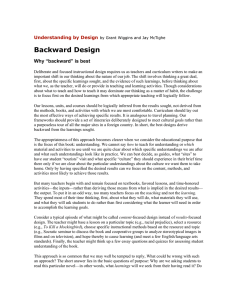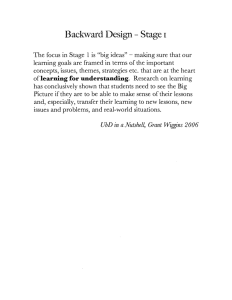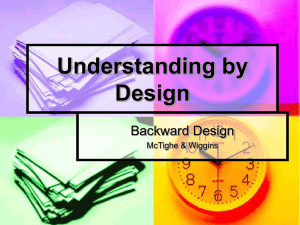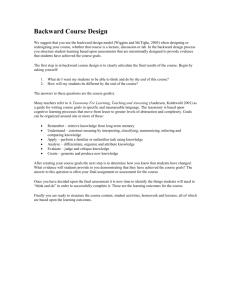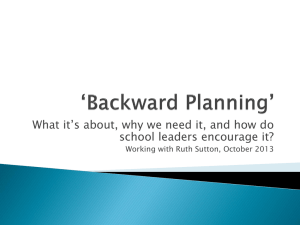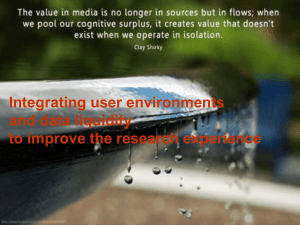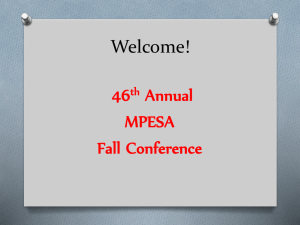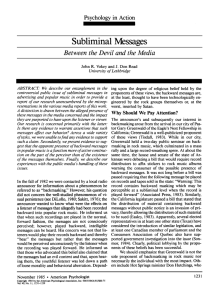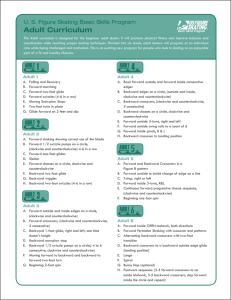Understanding by Design by Grant Wiggins and Jay McTighe
advertisement
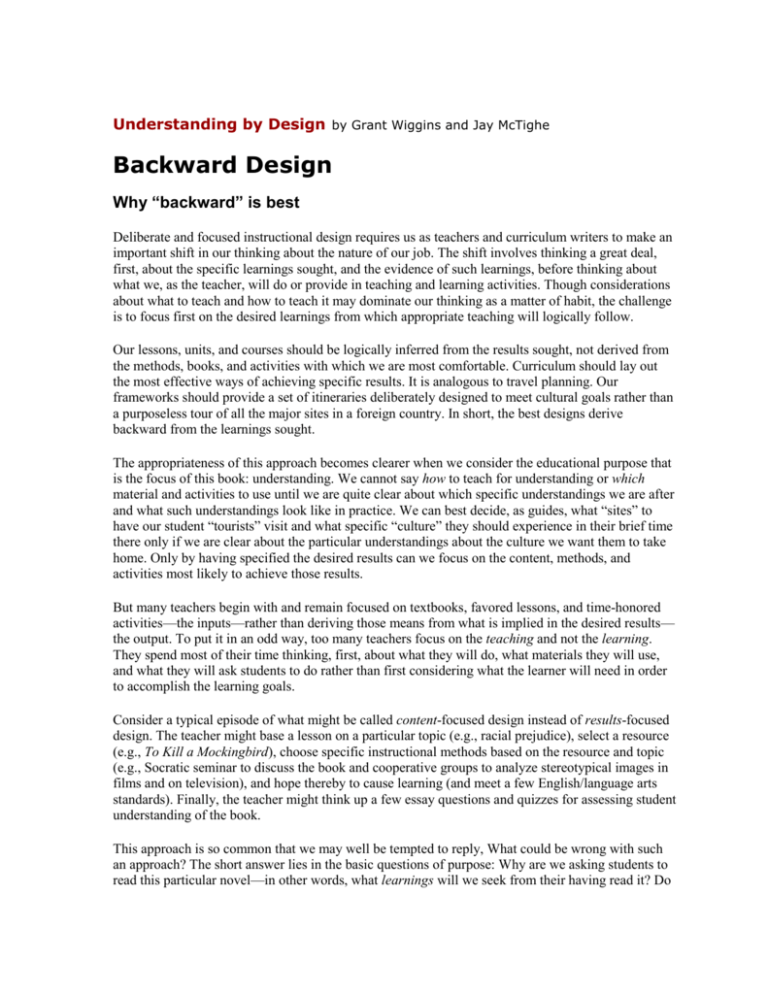
Understanding by Design by Grant Wiggins and Jay McTighe Backward Design Why “backward” is best Deliberate and focused instructional design requires us as teachers and curriculum writers to make an important shift in our thinking about the nature of our job. The shift involves thinking a great deal, first, about the specific learnings sought, and the evidence of such learnings, before thinking about what we, as the teacher, will do or provide in teaching and learning activities. Though considerations about what to teach and how to teach it may dominate our thinking as a matter of habit, the challenge is to focus first on the desired learnings from which appropriate teaching will logically follow. Our lessons, units, and courses should be logically inferred from the results sought, not derived from the methods, books, and activities with which we are most comfortable. Curriculum should lay out the most effective ways of achieving specific results. It is analogous to travel planning. Our frameworks should provide a set of itineraries deliberately designed to meet cultural goals rather than a purposeless tour of all the major sites in a foreign country. In short, the best designs derive backward from the learnings sought. The appropriateness of this approach becomes clearer when we consider the educational purpose that is the focus of this book: understanding. We cannot say how to teach for understanding or which material and activities to use until we are quite clear about which specific understandings we are after and what such understandings look like in practice. We can best decide, as guides, what “sites” to have our student “tourists” visit and what specific “culture” they should experience in their brief time there only if we are clear about the particular understandings about the culture we want them to take home. Only by having specified the desired results can we focus on the content, methods, and activities most likely to achieve those results. But many teachers begin with and remain focused on textbooks, favored lessons, and time-honored activities—the inputs—rather than deriving those means from what is implied in the desired results— the output. To put it in an odd way, too many teachers focus on the teaching and not the learning. They spend most of their time thinking, first, about what they will do, what materials they will use, and what they will ask students to do rather than first considering what the learner will need in order to accomplish the learning goals. Consider a typical episode of what might be called content-focused design instead of results-focused design. The teacher might base a lesson on a particular topic (e.g., racial prejudice), select a resource (e.g., To Kill a Mockingbird), choose specific instructional methods based on the resource and topic (e.g., Socratic seminar to discuss the book and cooperative groups to analyze stereotypical images in films and on television), and hope thereby to cause learning (and meet a few English/language arts standards). Finally, the teacher might think up a few essay questions and quizzes for assessing student understanding of the book. This approach is so common that we may well be tempted to reply, What could be wrong with such an approach? The short answer lies in the basic questions of purpose: Why are we asking students to read this particular novel—in other words, what learnings will we seek from their having read it? Do the students grasp why and how the purpose should influence their studying? What should students be expected to understand and do upon reading the book, related to our goals beyond the book? Unless we begin our design work with a clear insight into larger purposes—whereby the book is properly thought of as a means to an educational end, not an end unto itself—it is unlikely that all students will understand the book (and their performance obligations). Without being self-conscious of the specific understandings about prejudice we seek, and how reading and discussing the book will help develop such insights, the goal is far too vague: The approach is more “by hope” than “by design.” Such an approach ends up unwittingly being one that could be described like this: Throw some content and activities against the wall and hope some of it sticks. Answering the “why?” and “so what?” questions that older students always ask (or want to), and doing so in concrete terms as the focus of curriculum planning, is thus the essence of understanding by design. What is difficult for many teachers to see (but easier for students to feel!) is that, without such explicit and transparent priorities, many students find day-to-day work confusing and frustrating. The twin sins of traditional design More generally, weak educational design involves two kinds of purposelessness, visible throughout the educational world from kindergarten through graduate school. We call these the “twin sins” of traditional design. The error of activity-oriented design might be called “hands-on without being minds-on”—engaging experiences that lead only accidentally, if at all, to insight or achievement. The activities, though fun and interesting, do not lead anywhere intellectually. Such activity-oriented curricula lack an explicit focus on important ideas and appropriate evidence of learning, especially in the minds of the learners. A second form of aimlessness goes by the name of “coverage,” an approach in which students march through a textbook, page by page (or teachers through lecture notes) in a valiant attempt to traverse all the factual material within a prescribed time. Coverage is thus like a whirlwind tour of Europe, perfectly summarized by the old movie title If It's Tuesday, This Must Be Belgium, which properly suggests that no overarching goals inform the tour. As a broad generalization, the activity focus is more typical at the elementary and lower middle school levels, whereas coverage is a prevalent secondary school and college problem. No guiding intellectual purpose or clear priorities frame the learning experience. In neither case can students see and answer such questions as these: What's the point? What's the big idea here? What does this help us understand or be able to do? To what does this relate? Why should we learn this? Hence, the students try to engage and follow as best they can, hoping that meaning will emerge. The three stages of backward design Stage 1: Identify desired results What should students know, understand, and be able to do? What content is worthy of understanding? What enduring understandings are desired? In Stage 1 we consider our goals, examine established content standards (national, state, district), and review curriculum expectations. Because typically we have more content than we can reasonably address within the available time, we must make choices. This first stage in the design process calls for clarity about priorities. Stage 2: Determine acceptable evidence How will we know if students have achieved the desired results? What will we accept as evidence of student understanding and proficiency? The backward design orientation suggests that we think about a unit or course in terms of the collected assessment evidence needed to document and validate that the desired learning has been achieved, not simply as content to be covered or as a series of learning activities. This approach encourages teachers and curriculum planners to first “think like an assessor” before designing specific units and lessons, and thus to consider up front how they will determine if students have attained the desired understandings. Stage 3: Plan learning experiences and instruction With clearly identified results and appropriate evidence of understanding in mind, it is now the time to fully think through the most appropriate instructional activities. Several key questions must be considered at this stage of backward design: What enabling knowledge (facts, concepts, principles) and skills (processes, procedures, strategies) will students need in order to perform effectively and achieve desired results? What activities will equip students with the needed knowledge and skills? What will need to be taught and coached, and how should it best be taught, in light of performance goals? What materials and resources are best suited to accomplish these goals? Note that the specifics of instructional planning—choices about teaching methods, sequence of lessons, and resource materials—can be successfully completed only after we identify desired results and assessments and consider what they imply. Teaching is a means to an end. Having a clear goal helps to focus our planning and guide purposeful action toward the intended results. Conclusion Backward design may be thought of, in other words, as purposeful task analysis: Given a worthy task to be accomplished, how do we best get everyone equipped? Or we might think of it as building a wise itinerary, using a map: Given a destination, what's the most effective and efficient route? Or we might think of it as planning for coaching: What must learners master if they are to effectively perform? What will count as evidence on the field, not merely in drills, that they really get it and are ready to perform with understanding, knowledge, and skill on their own? How will the learning be designed so that learners' capacities are developed through use and feedback? This is all quite logical when you come to understand it, but “backward” from the perspective of much habit and tradition in our field. A major change from common practice occurs as designers must begin to think about assessment before deciding what and how they will teach. Rather than creating assessments near the conclusion of a unit of study (or relying on the tests provided by textbook publishers, which may not completely or appropriately assess our standards and goals), backward design calls for us to make our goals or standards specific and concrete, in terms of assessment evidence, as we begin to plan a unit or course. The rubber meets the road with assessment. Three different teachers may all be working toward the same content standards, but if their assessments vary considerably, how are we to know which students have achieved what? Agreement on needed evidence of learning leads to greater curricular coherence and more reliable evaluation by teachers. Equally important is the long-term gain in teacher, student, and parent insight about what does and does not count as evidence of meeting complex standards.
